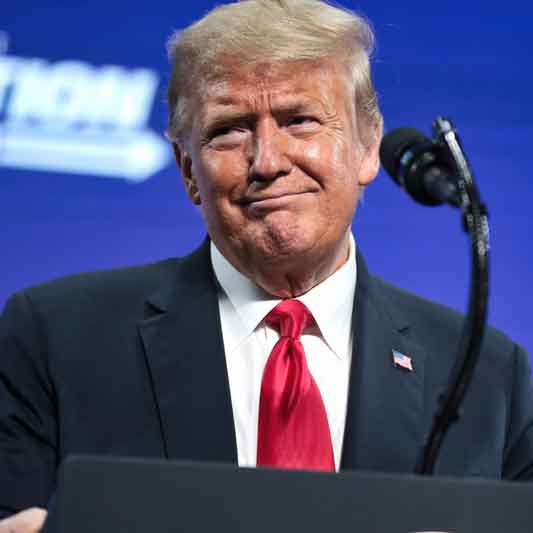During a press conference at the White House on Feb. 24, 2025, President Donald Trump announced his dissatisfaction with the U.S.-Mexico-Canada Agreement (USMCA), a trade pact he once endorsed. Trump highlighted the financial strain on Americans resulting from the agreement, which he himself signed in 2020.
Trump declared the initiation of a 25% tariff on all goods from Canada and Mexico, which had been previously postponed, starting the following week. He stated that the move would rectify USMCA issues. His comments appeared to oppose his administration’s own trade policy.
“I mean, who can blame them if they made these great deals with the United States, took advantage of the United States on manufacturing?” Trump said. “On just about anything, every aspect you can imagine, they took advantage.”
Trump further questioned the rationale for such agreements, ironically criticizing a deal he had personally advocated. “I look at some of these agreements, I’d read them at night, and I’d say, ‘Who would ever sign a thing like this?’ So the tariffs will go forward, yes, and we’re gonna make up a lot of territory. All we want is reciprocal. We want reciprocity,” he continued.
Trump’s comments marked a significant departure from his earlier stance on the USMCA. In 2020, he acclaimed it as the “best agreement we’ve ever made,” replacing the North American Free Trade Agreement (NAFTA) that he dubbed a “nightmare.” Trump had previously blamed the “worst trade deal ever made” on former President Bill Clinton, and used it as a focal point for criticism during his 2016 presidential campaign against Hillary Clinton.
The impending tariffs, first announced on February 1, 2025, were delayed for a month following discussions with Canadian and Mexican officials. However, Trump later confirmed that they will be implemented on March 4, 2025. The tariffs impose a 25% tax on most imports from Canada and Mexico, with Canadian energy exports facing a reduced 10% tariff. There will also be a separate 10% tariff on Chinese imports. The White House has justified this policy under the International Emergency Economic Powers Act (IEEPA), citing concerns over fentanyl trafficking and illegal immigration.
Back and forth discussions and negotiations are still active, and on March 6, Trump compromised on some of the details. He announced that some of the tariffs would be enacted for a few weeks, pending further negotiations with Mexico and Canada.
Analysts predict significant implications for all three nations as a result of these tariffs. The Brookings Institution suggests that they could reduce U.S. GDP growth by 0.25 to 0.3 percentage points, resulting in an economic output loss of $45 billion to $75 billion. The automotive and manufacturing industries are anticipated to be hit particularly hard, with rising costs of imported components likely leading to higher consumer prices. Canada and Mexico’s retaliations with their own tariffs would have further impact.
For American households, the tariffs could translate to increased costs of essential goods. Prices for housing materials, automobiles, and energy are also expected to rise.
The tariff announcement coincided with a significant political change in Canada. Prime Minister Justin Trudeau revealed his resignation on January 6, with the Liberal Party set to elect a new leader on March 9. This leadership transition has introduced an element of uncertainty into Canada’s trade negotiation strategy.
Under Trudeau’s administration, discussions with the U.S. were underway to prevent the tariffs. Canadian officials had also warned of retaliatory measures, including counter-tariffs on U.S. agricultural products, steel, and aluminum. However, with Trudeau’s departure, the response from the incoming Canadian leadership remains uncertain.
Mexico has also been negotiating to prevent the tariffs and has had some success reaching a compromise with the Trump administration. Mexican officials have argued that the tariffs violate the USMCA, which replaced NAFTA in 2020. While the agreement does include review mechanisms, U.S. officials maintain that national security concerns provide legal justification for the tariffs under IEEPA.
Mexico has hinted at potential countermeasures, including restrictions on U.S. agricultural exports. Analysts caution that further trade disruptions could lead to widespread economic consequences, as Mexico has become the United States’ largest trading partner.
The tariff decision raises broader questions about the future of USMCA, due for its first major review in 2026. The agreement increased North American content requirements for automobiles and imposed stricter labor standards, measures that Trump previously praised. However, his administration now suggests that further revisions may be needed to protect U.S. manufacturing.
While the White House insists that the tariffs aim to correct trade imbalances, economists warn they could disrupt North American economic integration. The tariffs may also test the durability of the USMCA, with potential legal actions under consideration by Canada and Mexico under the agreement’s dispute settlement mechanisms.
Business groups and policymakers continue to evaluate the impact of the tariffs and last-minute negotiations. For now, the Trump administration remains firm in its intent to enforce at least some of the new trade measures, marking a significant shift in U.S. economic policy towards its closest trading partners.

